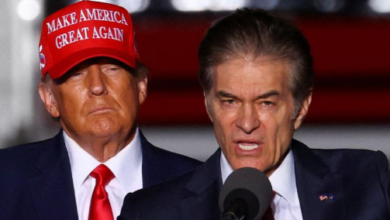The GOP’s Demonization Of Nancy Pelosi

On Friday, just hours after news broke that House Speaker Nancy Pelosi’s husband, Paul, was the victim of a violent attack in their home, Virginia Gov. Glenn Youngkin was speaking at a Republican campaign rally in his state.
The situation was serious. An intruder broke into the Pelosis’ house and beat Paul with a hammer. Youngkin took the opportunity to say that he didn’t condone any sort of violence ― but he still decided to make the Democratic leader a punchline.
“Speaker Pelosi’s husband, they had a break-in last night in their house, he was assaulted. There’s no room for violence anywhere, but we’re going to send her back to be with him in California,” Youngkin said. “That’s what we’re going to go do.”
Pelosi actually did return to California on Friday ― to be with her husband, who was undergoing surgery to repair a skull fracture and injuries to his right arm and hands.
Youngkin’s comment may have been tactless, but it wasn’t out of the ordinary for Republicans, who have made Pelosi their leading bogeyman for years. In speech after speech, and in ad after ad, Republicans have demonized Pelosi and at times used violent rhetoric in discussing her. She has long been the target of conservative ire ― and, at times, actual violence.
David DePape, the 42-year-old man who has been arrested in the attack, came to the house looking for the speaker and shouting, “Where is Nancy? Where is Nancy?” Authorities have not yet revealed a motive for the incident, but DePape’s internet presence suggests an obsession with far-right conspiracy theories.
“Nancy Pelosi has some of the thickest skin in politics,” said Faiz Shakir, an adviser to Sen. Bernie Sanders (I-Vt.) who once worked for Pelosi. “She’s taken all kinds of escalating verbal abuse for years and has always understood that if you want to be a leader, there’s a certain toughness that has to come with it. It’s absolutely horrendous that one of her detractors decided that physical violence was the only recourse to her strength.”
Pelosi became the first female speaker of the House in January 2007. Her centrality to Republican attacks really picked up in 2010, after Democrats approved the Affordable Care Act. “Fire Nancy Pelosi” became a GOP rallying cry. In the years since then, Republicans have said Pelosi is leading an “assault on your Second Amendment rights” and have accused her of “tyranny.” Tying a frontline Democrat to Pelosi ― a wealthy liberal woman from San Francisco ― is a no-brainer for Republicans in most congressional races.
She has become easy shorthand for Republicans to depict the Democratic Party as out of touch with regular Americans. They depict her, quite frankly, as a villain – or, as Donald Trump has called her, a “nasty, vindictive, horrible person.”
“From 2006 to January 6, she’s been the target of every kind of right-wing conspiracy and hate. You can’t feed people poison for years and then be surprised when what they do is toxic,” said Jesse Ferguson, a former top official at the Democratic Congressional Campaign Committee.
There have been many threats to her life. There was the North Carolina man who threatened to shoot Pelosi and came to D.C. with multiple guns and, according to the FBI, roughly 2,500 rounds of ammunition in 2021. That same year, an Arizona man called her Washington office and threatened to kill her. A Minnesota man also called her California office and threatened to inflict “pain in every way.” Then there was the Florida man who threatened to behead her in 2019.
On Jan. 6, 2021, as a violent mob of Trump supporters overtook the U.S. Capitol, police evacuated Pelosi because her life was at risk. Federal officials arrested a man who broke into her office, rifled through papers and took pictures of himself with his feet on a desk.
Nevertheless, Republicans have repeatedly sought to blame her for the attack on the Capitol, centered on inaccurate claims that she was personally responsible for the failure in security on Jan. 6.
And conservative media like Fox News regularly features segments and images like this:

Republicans continue to feature Pelosi in attack ads this election cycle. In fact, as I’m sitting here writing this piece, a campaign commercial popped up during the World Series game tying Rep. Abigail Spanberger (D-Va.) to the liberal speaker. The rhetoric is not always violent, but sometimes it is.
“I want you to watch Nancy Pelosi hand me that gavel. It will be hard not to hit her with it,” House Minority Leader Kevin McCarthy (R-Calif.) told reporters in August, discussing the GOP winning back the House in the November elections. His spokesperson said he was “obviously joking.”
Pelosi has long been concerned about the effects of violent political rhetoric. In 2009, HuffPost’s Jonathan Nicholson, then a reporter with Bloomberg Government, asked Pelosi about whether she was worried about violence from the burgeoning tea party movement. She invoked the assassination of city Supervisor Harvey Milk in San Francisco in 1978.
“I have concerns about some of the language that is being used because I saw this myself in the late ’70s in San Francisco, this kind of rhetoric. … It created a climate in which violence took place,” she said, adding, “I wish we would all curb our enthusiasm in some of the statements and understand that some of the ears that it is falling on are not as balanced as the person making the statements may assume.”
[ad_2]
Source link





